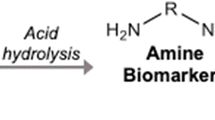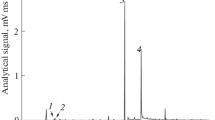Summary
Five male subjects were exposed to 1,6-hexamethylene diisocyanate (HDI) atmospheres for 7.5 h. The exposures were performed in an 8 m3 stainless steel test chamber, and the HDI atmospheres were generated by a gas-phase permeation method. HDI in air was determined by an HPLC method utilizing the 9-(N-methylaminomethyl)-anthracene reagent, and by a continuous monitoring device (MDA 7100). The average air concentration was ca 25 μg/m3, and the inhaled dose of HDI for the different subjects was estimated at ca 100 μg. The related amine 1,6-hexamethylene diamine (HDA) was, after acid hydrolysis of urine and plasma, determined as a heptafluorobutyric derivative, by glass capillary gas-chromatography and selected ion monitoring (SIM), in a chemical ionization mode using ammonia as reagent gas. The cumulated urinary excretion of HDA during 28 h was 8.0 to 14 μg, which corresponds to ca 11 to 21% of the inhaled dose of HDI. The urinary level of HDA, in samples collected immediately after the end of the exposures, was on average 0.02 mmol/mol creatinine (range 0.01–0.03 mmol/mol creatinine). The urinary elimination was rapid, and half-time (t1/2), for the concentration of HDA in urine, showed an average of 1.2 h (range 1.1–1.4 h). No specific IgE and IgG antibodies to HDI were detected before and after provocation; nor were spirometry or bronchial reactivity changed immediately and 15 h after provocation. Analysis of HDA in hydrolysed urine, as a marker of short-time exposure to HDI, is proposed.
Similar content being viewed by others
References
Berode M, Leuenberger Ph, Savolainen H (1988) Phenotypedependant inhibition of human α1-antitrypsin by 1,6-hexane diamine in vitro. Biochem Int 17:141–145
Brorson T, Skarping G, Sandström J, Stenberg M (1990) Biological monitoring of isocyanates and related amines. I. Determination of 1,6-hexamethylene diamine (HDA) in hydrolysed human urine after oral administration of HDA. Int Arch Occup Environ Health 62:79–84
Brorson T, Skarping G, Renman L, Sango C (1989) Test atmospheres of diisocyanates with special reference to controlled exposure of humans. Int Arch Occup Environ Health 61:495–501
Brorson T, Sangö C, Skarping G, Renman L (1990) Evaluation of chromatographic methods for the determination of isocyanates in air. Int J Environ Anal Chem 38:399–413
Brown WE, Wold F (1973) Alkyl isocyanates as active-sitespecific reagents for serine proteases. Reaction properties. Biochemistry 12:828–834
Dalene M, Skarping G, Brorson T (1990) Chromatographic determination of amines in biological fluids with special reference to the biological monitoring of amines and isocyanates. IV. Determination of 1,6-hexamethylene diiamine (HDA) in human urine using capillary gas chromatography and selective ion detection. J Chromatogr (in press)
Ferris BG (1978) Epidemiology standardization projects. Am Rev Resp Dis 118:1–120
Hagmar L, Nielsen J, Skerfving S (1987) Clinical features and epidemiology of occupational obstructive respiratory disease caused by small molecular weight organic chemicals. Monographs in Allergy, S Karger, Basel, 21:42–58
Hanson A, Melander A, Wåhlin-Boll E (1981) Acetylator phenotyping: a comparison of the isoniazid and dapsone tests. Eur J Clin Pharmacol 20:233–234
Heby O, Jänne J (1981) Polyamine antimetabolites: biochemistry, specificity and biological effects of inhibitors of polyamine synthesis. In: Polyamines in biology and medicine. Morris DR, Morten CJ (eds) Marcel Dekker Inc, New York, pp 244–310
Nielsen J, Sango C, Winroth C, Hallberg T, Skerfving S (1985) Systemic reactions associated with polyisocyanate exposure. Scand J Work Environ Health 11:51–54
Pegg AE, Conover C, Wrona A (1978) Effects of aliphatic diamines on rat liver ornithine decarboxylase activity. Biochem J 170:651–660
Rosenberg C, Savolainen H (1986) Determination in urine of diisocyanate-derived amines from occupational exposure by gas chromatography — mass fragmentography. Analyst 111:1069–1071
Sangö C, Zimerson E (1980) A new reagent for determination of isocyanates in working atmospheres by HPLC using UV or fluorescence detection. J Liq Chromatogr 3:971–990
Skarping G, Dalene M, Brorson T, Sandström J, Sango C, Tiljander A (1989) Chromatographic determination of amines in biological fluids with special reference to the biological monitoring of amines and isocyanates. I. Determination of 1,6hexamethylene diamine with chloroformates and heptafluorobutyricacid anhydride using nitrogen selective detection. J Chromatogr 479:125–133
Subramanyam B, Callery PS, Geelhaar LA, Egorin MJ (1989) A cyclic imine intermediate in the in vitro metabolic conversion of 1,6-diaminohexane to 6-aminohexanoic acid and caprolactam. Xenobiotica 19:33–42
Ted Tse CS, Pesce AJ (1979) Chemical characterization of isocyanate-protein conjugates. Toxicol Appl Pharmacol 51:39–46
Welinder H, Nielsen J, Bensryd I, Skerfving S (1988) IgG antibodies against polyisocyanates in car painters. Clin Allergy 18:85–93
Author information
Authors and Affiliations
Rights and permissions
About this article
Cite this article
Brorson, T., Skarping, G. & Nielsen, J. Biological monitoring of isocyanates and related amines. Int. Arch Occup Environ Heath 62, 385–389 (1990). https://doi.org/10.1007/BF00381369
Received:
Accepted:
Issue Date:
DOI: https://doi.org/10.1007/BF00381369




